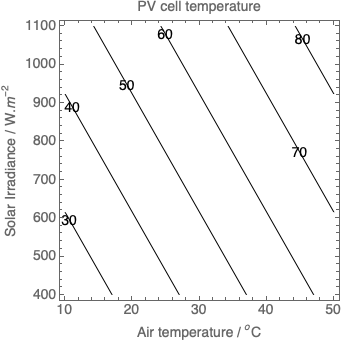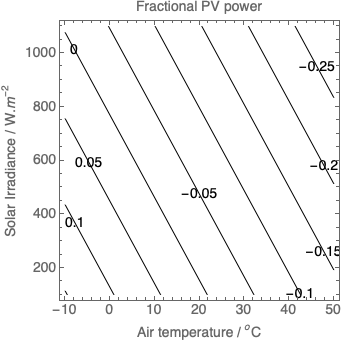A solar panel will deliver the most electrical power when the sun shines brightly, but sunny days result in high air temperatures. Do high temperatures affect the power supplied by solar cells?
The short answer is yes. The current supplied by the solar panel will rise marginally but the voltage drops somewhat faster so the power (voltage times current) is lower. Quite how much lower depends on the technology.
Solar panels are tested at room temperature (25 o C) so the power that is specified by the manufacturer corresponds to the unusual situation of the panel operating at room temperature while under strong sunlight. The solar panel manufacturer will also state a Temperature coefficient of power which indicates how the power delivered by the panel will change with temperature. A typical, conservative value for an inexpensive multi-crystalline module is -0.48% / oC.
To estimate how much power is lost due to high temperatures we need to know how much hotter than 25 oC a solar module will become. It stands to reason that the solar panel will become hottest on sunny days with a high air temperature. The following equation below provides a rough estimate, relating the solar cell temperature to the air temperature, solar irradiance and a factor called NOCT.

The solar irradiance, S, is a measure of the intensity of the sunlight and measured by meteorological stations. NOCT stands for Normal Operating Cell Temperature. Like the temperature coefficient of power, NOCT is measured by the manufacturer and accounts for the heating of the panel from sunlight. A typical NOCT value for solar panels is 46 oC. The graph below shows the panel temperature as a function of irradiance and air temperature,
Estimated solar cell temperature plotted as a function of irradiance and air-temperature.
Let us now calculate how much power is lost when a solar module operates at temperatures a temperature other than 25oC. The graph below shows the result as a function of solar irradiance (S) and air temperature.
Fractional power from a PV system as a function of air temperature and solar irradiance. Negative values indicate a power loss, positive values indicate a power gain
So on a 35o day with bright sunshine (1000W.m-2), we see that a solar power plant could be expected to operate at 20% lower power, so 80% of its potential, due to the elevated solar module temperature. We also notice that on cold days, a solar panel can be expected to outperform its specification. There is nothing special about the temperature at which solar panels are tested (25oC). If they operate at higher temperatures the power delivered goes down, at lower temperatures it goes up. It is unusual but not impossible for the latter to occur and corresponds to the region where the fractional power is positive in the graph above.
Different solar cell technologies have different temperature coefficients. The values stated above are for low-cost multi-crystalline silicon solar panels. Premium products, such as SunPower’s X-series panel has a lower temperature coefficient of power of -0.29%/oC. To determine whether it is worth building a power plant using premium or standard solar panels, a photovoltaic system installer will run a few scenarios using a computer simulation that will use historic meteorological data to account for a wide range of effects in addition to temperature losses; for example panel orientation, shading and surface reflection.
Finally, and in part to address misunderstandings elsewhere on the internet:
- The power from a solar panel drops with temperature and described by the temperature coefficient of power, typically -0.5%/oC for silicon solar panels.
- The current from a solar panel rises slightly (and linearly) with temperature . There is another temperature coefficient that describes this, the temperature coefficient for current which for c-Si is typically +0.034%/oC, so the effect is small.
- The voltage from a solar panel drops sub-linearly with temperature giving rise to yet another temperature coefficient for voltage. For c-Si this is -0.34%/oC, so the loss in voltage is much larger than the modest gain in current, hence overall loss of power.
Further Reading
- PV-Education.org have an excellent resource on all aspects of photovoltaic solar cells. Pertainant to this post is the section on Heat Loss in PV modules.
- 'Thermal Behavior of Photovoltaic Devices', Olivier Dupré, Rodolphe Vaillon & Martin A. Green, Springer International Publishing, 2017. ISBN: 978-3-319-49456-2

